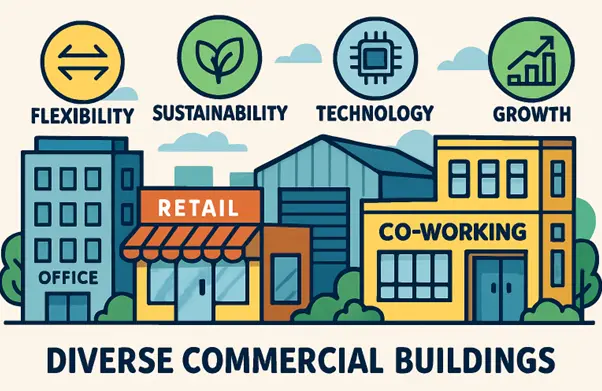The world of commercial real estate is in constant flux, with new dynamics emerging as the market responds to societal, economic, and technological changes. For business owners navigating 2025, staying ahead of these trends is critical for both strategic decision-making and long-term growth. As you monitor shifts in workspace demand, technological advancements, and evolving retail models, it’s important to seek advice and perspectives from those with a deep understanding of regional markets, such as the Santa Fe NM real estate experts Summit Group Real Estate Professionals.
Adaptability is now more valuable than ever, with sustainability, innovation, and flexibility at the forefront of commercial property decisions. In the following guide, you’ll find a comprehensive take on the top commercial real estate trends for 2025, supported by reliable, market-sourced data and expert insights.
Flexible Workspaces: Adapting to Hybrid Models
The commercial office space narrative has shifted dramatically, with many companies permanently embracing hybrid and remote work policies post-pandemic. More organizations are searching for office arrangements that can quickly flex in size, technology needs, and duration. This trend supports the surge of co-working spaces and adaptive work hubs, allowing businesses to efficiently expand or contract based on headcount and workflow changes. Flexible lease terms not only reduce risk but also offer agility—an increasingly valued asset in today’s volatile economic landscape. Learn more about flexible workspace trends.
Sustainability Initiatives: Embracing Green Practices
Going Beyond Energy Efficiency
Sustainability has progressed beyond “nice to have” to become a necessity in the commercial space. Business owners now actively seek out properties with sustainable designs—think LEED certifications, smart HVAC, and renewable energy installations. These features, once considered premium, are fast becoming the default expectation due to stricter government standards and growing consumer awareness around environmental stewardship. Green practices not only lower utility costs and carbon footprints, but also help businesses present themselves as socially responsible brands, strengthening their connection to eco-minded customers and partners.
Technological Integration: Enhancing Efficiency
Smart Buildings and AI Solutions
The deployment of cutting-edge technology in real estate is revolutionizing building management, tenant relations, and financial forecasting. From AI-powered predictive maintenance to comprehensive IoT sensor networks that control lighting, security, and climate in real time, these innovations lead directly to cost savings, robust security, and optimized occupancy. Technology also facilitates seamless tenant experiences, such as mobile booking for shared amenities and contactless entry systems. Eventually, AI-based insights may predict market movements or flag operational inefficiencies before they lead to revenue loss, placing tech-savvy businesses a step ahead.
Retail Resilience: The Strength of Physical Stores
Open-Air Centers outpace Retail Apocalypse Predictions
Despite the digital shopping boom, physical retail—especially well-situated open-air shopping centers—has demonstrated unexpected strength. Shoppers are drawn to experiences that can’t be replicated online: convenient social outings, hands-on product browsing, and unique food or entertainment offerings. As a result, top open-air retail centers are reporting the lowest vacancy rates in a decade, which is driving landlords to renegotiate leases at higher rates as supply remains tight. The sector’s resilience lies in its ability to offer what e-commerce cannot: immediacy, discovery, and community.
Industrial Sector Growth: Meeting E-commerce Demands
Logistics, Warehousing, and the Last-Mile Imperative
The digital economy’s breakneck pace is fueling unrelenting demand for industrial properties, especially those that support logistics and rapid delivery infrastructure. Warehouses and distribution centers near major urban corridors have become vital, allowing products to get to consumers quickly and reliably through last-mile delivery solutions. Strategic location, transportation accessibility, and high-tech inventory management define the most sought-after facilities. With e-commerce growing, expect this sector to continue outpacing other commercial categories for the foreseeable future.
Conclusion
Commercial real estate is proving to be as adaptive as the businesses it houses. As 2025 unfolds, business owners that embrace hybrid workspace solutions, invest in sustainable assets, leverage game-changing technology, recognize the vitality of thriving retail centers, and plan for industrial expansion will be best positioned to compete and grow. Staying attuned to these trends—and working with regional professionals who can offer tailored guidance—will be a game-changer in a continually evolving property landscape.
Also Read- How to Style Real Kundan Necklaces with Modern Western Outfits


